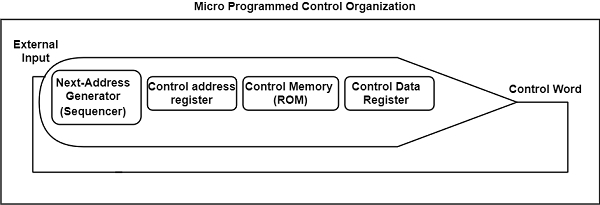
 Data Structure
Data Structure Networking
Networking RDBMS
RDBMS Operating System
Operating System Java
Java MS Excel
MS Excel iOS
iOS HTML
HTML CSS
CSS Android
Android Python
Python C Programming
C Programming C++
C++ C#
C# MongoDB
MongoDB MySQL
MySQL Javascript
Javascript PHP
PHPPhysics
Chemistry
Biology
Mathematics
English
Economics
Psychology
Social Studies
Fashion Studies
Legal Studies
- Selected Reading
- UPSC IAS Exams Notes
- Developer's Best Practices
- Questions and Answers
- Effective Resume Writing
- HR Interview Questions
- Computer Glossary
- Who is Who
What is Control Memory?
A control memory is a part of the control unit. Any computer that involves microprogrammed control consists of two memories. They are the main memory and the control memory. Programs are usually stored in the main memory by the users. Whenever the programs change, the data is also modified in the main memory. They consist of machine instructions and data.
The control memory consists of microprograms that are fixed and cannot be modified frequently. They contain microinstructions that specify the internal control signals required to execute register micro-operations.
The machine instructions generate a chain of microinstructions in the control memory. Their function is to generate micro-operations that can fetch instructions from the main memory, compute the effective address, execute the operation, and return control to fetch phase and continue the cycle.
The figure shows the general configuration of a microprogrammed control organization.

Here, the control is presumed to be a Read-Only Memory (ROM), where all the control information is stored permanently. ROM provides the address of the microinstruction. The other register, that is, the control data register stores the microinstruction that is read from the memory. It consists of a control word that holds one or more micro-operations for the data processor.
The next address must be computed once this operation is completed. It is computed in the next address generator. Then, it is sent to the control address register to be read. The next address generator is also known as the microprogram sequencer. Based on the inputs to a sequencer, it determines the address of the next microinstruction. The microinstructions can be specified in several ways.
The main functions of a microprogram sequencer are as follows −
- It can increment the control register by one.
- It can load the address from the control memory to the control address register.
- It can transfer an external address or load an initial address to begin the start operation.
The data register is also known as the pipeline register. It allows two operations to be performed at a time. It allows performing the micro-operation specified by the control word and also the generation of the next microinstruction.
A dual-phase clock is required to be applied to the address register and the data register. It is possible to apply a single-phase clock to the address register and work without the control data register.
The main advantage of using a microprogrammed control is that, if the hardware configuration is established once, no further changes can be done. However, if a different control sequence is to be implemented, a new set of microinstructions for the system must be developed.

